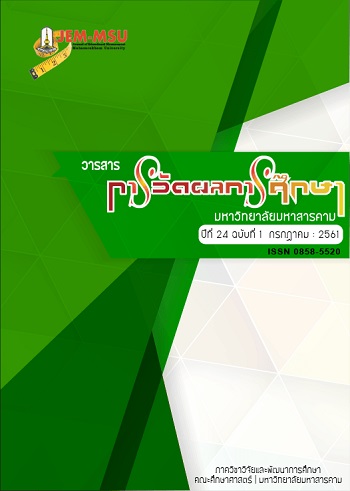The Result of Using Cooperative Learning with the TPR Activities to Promote English Capacity for Communication, Analytical Thinking And Self–Confidence of Prathomsueksa 6 Students
Main Article Content
Abstract
The purposes of this research were: (1) to determine the effectiveness of lesson plans for English communication of Prathomsueksa 6 students by using cooperative learning with the TPR activities with an efficiency criterion of 70/70, (2) to compare the English communication capable of Prathomsueksa 6 students by using cooperative learning with the TPR activities between pretest and posttest,(3) to study the analytical thinking capable of Prathomsueksa 6 studentsby using cooperative learning with the TPR activities (4) to study the capable of self – confidence of Prathomsueksa 6 students whom learn by using cooperative learning with the TPR activities. The sample size was 14 Prathomsueksa 6 students at Jatukamwittaya School, Roi - Et Primary Educational Service Area Office 2 obtained through Multi – Stage Random Sampling techniqueThe tools of this research consisted of 10 TPR lesson plans and other assessment tools such as 30 item(B =0.36-0.86 rcc = 098), of English for communication test, 20 item, an analytical thinking test, 15 item, (p=0.57-0.92)The evaluation of student self-confidence 15 item, The statistical data were percentage of students’ satisfaction, means and standard deviation. The Wilcoxon was used for testing the hypothesis.
The results of the study were as follows:
- An efficiency of English lesson plans for communication of Prathomsueksa 6 students by using cooperative learning with the TPR activities was 79.99/76.43 higher than the established criterion of 70/70.
- The capable of English for communication of Prathomsueksa 6 studentsafter using cooperative learning with the TPR activities washigher than before and statistically significant at the level .05
- An analytical thinking capable of Prathomsueksa 6 students by using cooperative learning with the TPR activities was at high level.
4. The self - confidence of Prathomsueksa 6 students by using cooperative learning with the TPR activities was at high level.
Article Details
The content and information contained in the published article in the Journal of Educational Measurement Mahasarakham University represent the opinions and responsibilities of the authors directly. The editorial board of the journal is not necessarily in agreement with or responsible for any of the content.
The articles, data, content, images, etc. that have been published in the Journal of Educational Measurement Mahasarakham University are copyrighted by the journal. If any individual or organization wishes to reproduce or perform any actions involving the entirety or any part of the content, they must obtain written permission from the Journal of Educational Measurement Mahasarakham University.
References
สหกรณ์การเกษตรแห่งประเทศไทย.
2. กระทรวงศึกษาธิการ.(2554).แนวทางการดำเนินงานเรียนฟรี 15 ปีอย่างมีคุณภาพ ปีงบประมาณ 2554.
กรุงเทพฯ : ม.ป.พ.
3. นิกร ปัตรัตน์.(2554). การเปรียบเทียบทักษะการใช้ภาษาอังกฤษเพื่อการสื่อสาร ความเชื่อมั่นในการใช้
ภาษาอังกฤษเพื่อการสื่อสาร และความคงทนในการเรียนรู้ระหว่างการจัดกิจกรรมการสอน ภาษาอังกฤษแบบโครงงานและและโต้ตอบทางสรีระ ของนักเรียนชั้นมัธยมศึกษาปีที่ 1.วิทยานิพนธ์ปริญญาการศึกษามหาบัณฑิต สาขาหลักสูตรและการสอน คณะศึกษาศาสตร์ มหาวิทยาลัยมหาสารคาม.
4. ปทิตตา ติวงค์.(2555).การพัฒนาความสามารถด้านการฟัง-พูด ภาษาอังกฤษโดยใช้วิธีสอนแบบ
ตอบสนองด้วยท่าทางของนักเรียนชั้นประถมศึกษาปีที่ 5.วิทยานิพนธ์ปริญญาการศึกษามหาบัณฑิต สาขาหลักสูตรและการสอน มหาวิทยาลัยทักษิณ.
5. เผชิญ กิจระการ.(2544).การวิเคราะห์ประสิทธิภาพสื่อและเทคโนโลยีเพื่อการศึกษา (E1/E2)วารสาร
วัดผลการศึกษา,ปีที่7, 44 – 51.
6. วิมลรัตน์ สุนทรโรจน์.(2554).นวัตกรรมตามแนวคิดแบบ Backward Design. กรุงเทพฯ: ช้างทอง.
7. _______. (2554). นวัตกรรมเพื่อความรู้. มหาสารคาม : มหาวิทยาลัยมหาสารคาม.
ภาควิชาวิจัยและพัฒนาการศึกษา(2553). พื้นฐานการวิจัยการศึกษา.พิมพ์ครั้งที่ 5. มหาสารคาม :
คณะศึกษาศาสตร์ มหาวิทยาลัยมหาสารคาม.
8. รุ่งทิวา อุ่นเจริญ.(2557).การเปรียบเทียบผลสัมฤทธิ์ทางการเรียนและทักษะการสื่อสารภาษาอังกฤษของ
นักเรียนชั้นประถมศึกษาปีที่ 4 ระหว่างการจัดกิจกรรมการเรียนรู้แบบ TPR และการจัดกิจกรรมการเรียนรู้แบบ B-SLIM.วิทยานิพนธ์ปริญญาการศึกษามหาบัณฑิตสาขาหลักสูตรและการสอนมหาวิทยาลัยนครพนม.
9. วิภาภรณ์ บุตรนาม.(2556).การเปรียบเทียบผลสัมฤทธิ์ทางการเรียนภาษาอังกฤษเพื่อการสื่อสารและ
ความเชื่อมั่นในตนเองของนักเรียนชั้นประถมศึกษาปีที่ 2 ระหว่างการจัดกิจกรรมแบบ TPR และแบบ CLE.วิทยานิพนธ์ปริญญาการศึกษามหาบัณฑิต สาขาหลักสูตรและการสอน คณะศึกษาศาสตร์ มหาวิทยาลัยมหาสารคาม.
10. ศิริภรณ์ ศรีนาค.(2550). การเปรียบเทียบผลสัมฤทธิ์และเจตคติต่อการเรียนภาษาอังกฤษของนักเรียนชั้น
ประถมศึกษาปีที่ 3 โดยใช้วิธีสอนแบบตอบสนองด้วยท่าทาง (TPR) กับวิธีการสอนตามแนว
ทางการสอนภาษาเพื่อการสื่อสาร.วิทยานิพนธ์ปริญญาคุรุศาสตร์บัณฑิต สาขาหลักสูตรและ การสอน มหาวิทยาลัยราชภัฎเทพกษัตริย์ตรี.
11. สิริวิภา จอกลบ.(2553).ทักษะการฟังและการพูดภาษาอังกฤษของนักเรียนชั้นประถมศึกษาปีที่ 2 ที่ได้รับ
การจัดกิจกรรมการสอนแบบตอบสนองด้วยท่าทาง (TPR). การศึกษาค้นคว้าอิสระปริญญาศึกษาศาสตร์มหาบัณฑิตสาขาหลักสูตรและการสอนมหาวิทยาลัยขอนแก่น.
12. Asher,J.J.(1979).Learning Another Language Through Action . The Complete Teacher’s
Guide Book Los Gatos. California : Sky Oaks Publication.
13. Mattisson, J. (2010). Using TPR Method in Teaching English Adjectives. Retrieved July 20,
2013, from www.diva-portal.org.


